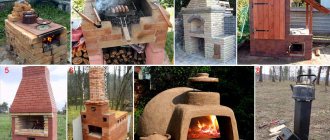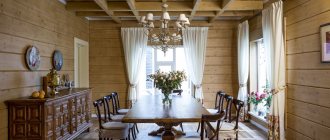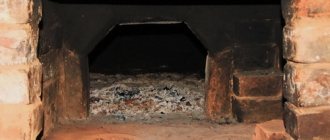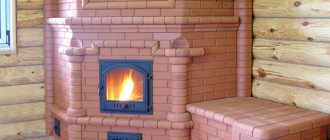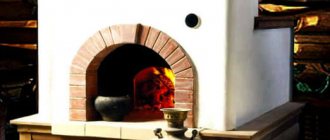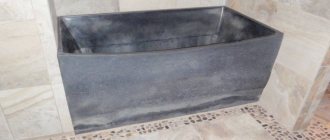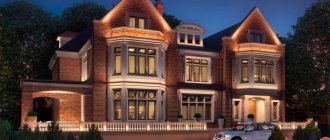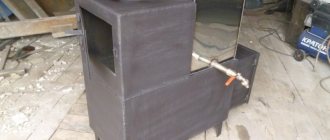A classic wood-burning fireplace gives a home a unique coziness and charm, but many consider it too expensive, believing that laying a brick fireplace with your own hands is a job for professionals.
DIY brick fireplace
In fact, this task is not so difficult, it is enough to find a suitable drawing or ordering diagram, stock up on materials, and a real fireplace with crackling wood in it will appear in your home.
Advantages
Modern technologies keep pace with people's needs. It is for this reason that the long-known brick stoves have been replaced by new fireplace stoves. This design is a monoblock with a pipe channel and is installed on a single base. Moreover, each element has its own special meaning.
Conventional stoves have no decorative value, but you can cook with them. Fireplaces can please the eye and heat the room. But the fireplace-stove combines the functionality of both devices with an interesting design. It's like a fireplace with a stove - very convenient and functional. The main advantages of a brick stove-fireplace:
- The structure can warm up the air in the room quite quickly.
- The stove and fireplace can be used separately from each other. You can only cook or only heat the room - as you wish.
- Efficiency is about 80%.
- Ash pans with holes under each firebox make the cleaning process very simple and quick.
- When manufactured with high quality, a brick fireplace stove will serve for decades.
The structure can be installed in such a way that the stove will be localized in the kitchen space, and the fireplace in the living room. If a real master gets down to business, the fireplace stove turns into a real work of art and will decorate your home for many years. A brick fireplace stove would be a good choice for a country house. This will save on heating and electrical costs in general. This design can also be used as needed.
Test kindling
The solution continues to dry from 10 to 14 days, after which the first kindling can be performed.
It is important that the temperature of the masonry increases gradually to avoid cracking. To do this, set fire to wood chips or a small bundle of brushwood with the damper open.
Note!
Insulate the foundation with your own hands - a step-by-step description of the use of the best materials and technologies (90 photos)
- Do-it-yourself pergola on a summer cottage: step-by-step instructions with photos and descriptions
Laying laminate flooring with your own hands: a detailed description of how to lay laminate flooring. Laminate calculation, step-by-step description and installation secrets (105 photos and videos)
Firewood must be added little by little, and at the same time watch out for cracking of the walls, as well as the fireplace chimney. Any cracks that appear are sealed with the same solution.
Options
There are quite a few variations of brick units. They differ in complexity and functionality. The most common types are: Swedish, Finnish, Russian and Dutch. There are also modified versions of stoves that are named after their creators.
There are ovens that do not have a hob at all. They represent a rudimentary wall structure with smoke exhaust channels, fireboxes, cleaning and blower chambers located between them. Such units are used for heating. Another option is a fireplace-stove with a heating and hob surface. Such stoves attract people with their versatility. They are more complex to design and install. Let's consider several interesting types of brick fireplaces and stoves:
With open firebox
Fireplaces with an open firebox allow you to warm up the air in the room in a fairly short time. If this design includes a hob, cooking is very easy. Owners of such fireplace-stoves can install barbecues right in the house and barbecue at any time of the year.
With air heating
Air-heated fireplaces are considered the best for heating a home. In such designs, a cast iron firebox is used. The duct system extends throughout the house and the casing in combination gives the desired result - complete heating. The system works in such a way that cold air is directed directly into the firebox, heats up and rises up through the pipes.
With water heating
Fireplaces with water circuits are gaining popularity. This design may include a heating and hob panel. A stove connected to heating has a great advantage over its counterparts - it pleases the eye, warms the whole house, and makes it possible to cook. Such designs are often used for baths.
As already mentioned, there are modification options. But knowing the basic models, you can easily choose the format that is convenient for you.
Firebox dimensions
The fireplace in the house plan and its drawing and diagram must be ready long before installation work begins. The project must be based on both the room and the financial capabilities of the home owner. Every 10 centimeters in one of the dimensions gives a significant increase in price, but this absolutely does not mean that the more the better. Everything should be correlated and made in suitable proportions. The outside must be consistent with the inside. It is important to understand whether a fireplace was planned when designing the house or not. If such preparation has been carried out, then there will be no difficulties. However, if the repairs have already been made and you need to assemble the classic brick version, then the following should be taken into account:
- Get advice from professionals who will point out all sorts of pitfalls.
- Assess the level of readiness of floors for additional load
- Choose the correct location.
- Check the possibility of removing the chimney pipe.
- Take into account the external dimensions (including firewood boxes).
We recommend taking a closer look at the design based on a convection box. This alternative to the classical method is the most popular at the moment.
Advantages:
- fast heating;
- efficient fuel consumption;
- takes up less space;
- has a reasonable price.
Stylistics
A well-chosen fireplace should be combined with the overall style of your interior. Only then will such an addition look beautiful. Fireplace stoves are often made independently or to order. The Finnish model is quite popular. Let's look at the most popular styles in which this unit is made:
Minimalism
Minimalism is characterized by strict forms and lines. In houses of this style, small fireplaces are installed, which serve a decorative and heating role. A laconic design with a minimum number of decorative parts is the perfect set. Any room in your home will become even more cozy when it has a mini fireplace.
A small fireplace stove will fit well into a minimalist interior and will delight you and your guests. In addition, this option is well suited for houses with a small area. Here you can also install a structure in which the stove will face the kitchen, and the fireplace itself will face the living room.
Classic
Fireplaces of this style were the first. They were installed by noble people as an interesting piece of furniture and a sign of their superiority. Such fireplace stoves always have the correct shape and only expensive finishing or carving.
Such units usually go flush with the wall. This arrangement determines the main decorative accent on the firebox itself. All designs of such furnaces include a U-shaped portal. But you can also choose a non-embedded option. In this case, the fireplace stove is located against the wall, and the chimney is covered with a stylized casing.
Modern
This type of fireplace stove is often chosen by young people. You can buy a lot of interesting options. Such units are often used as architectural details. These fireplaces are often installed so that they blend into the wall and resemble a window with a fire. An interesting option is when a double-sided fireplace stove is installed in the interior wall. With this arrangement, you can use the structure as a piece of furniture on one side, and on the other as a stove.
Rustic
These are country style fireplaces. This design will look good in a wooden house. Natural wood ceilings, harmoniously selected wall finishes and dark floors. Moreover, using wallpaper in this case is completely impractical. They will quickly become unusable due to the stove. A Russian stove works well. Carved decorative elements will add originality and exclusivity.
Venetian
Fireplace stoves of this style are quite massive and clearly stand out against the background of the wall. They are designed to show everyone around their power and sophistication in one person. In an interior of the appropriate style, such fireplaces look like a charming integral attribute.
Foundation arrangement
- Compact the bottom of the pit with a depth equal to the foundation of the house;
- Place sand on the bottom and compact it in a layer of at least 0.1 m;
- Fill the pit with rubble stone to the soil level, filling the gaps with a solution of lime and clay or a cement mixture;
- Level the concrete on top, and after hardening, cover it with two layers of roofing material;
- Install wooden formwork to the floor of the room. The dimensions of the foundation in all directions must exceed the dimensions of the fireplace by 5 cm;
- Make a mesh from steel reinforcement with a diameter of 1.2 to 1.5 cm and install it using wooden blocks at a height of 50 mm from the waterproofing;
- Pour concrete mortar (M400 cement - 1 hour, crushed stone - 5 hours, sand - 3 hours) into the formwork and use a level to create a horizontal surface;
- The concrete will harden within 7 days, after which the formwork will be removed and the foundation covered with bitumen mastic. Wait another 3 weeks, and then cover the foundation with 2 layers of roofing felt waterproofing.
Principle of operation
Any stove has three main components: firebox, pipe, chimney. The main part is the firebox. This is where the wood burns. There is a hole at the bottom. Through it, air enters the firebox, which is necessary for combustion. This hole is covered with a special grill, so the firewood does not fall out. Air gets inside the firebox, and ash and other combustion products fall from the firebox into the hole.
There is a special door that allows you to put firewood into the firebox. And the firebox itself is closed on all sides. Just above the firebox is the hob. It is heated by fire and allows you to cook food. Oven ovens work the same way.
The ash pan chamber is located under the firebox. It also has a door to allow the chamber to be cleaned. The door is also able to regulate the amount of air that enters the firebox. In the arch of the firebox there is another hole - hailo. It is through it that hot air comes out, which heats the oven.
The pipes are designed to remove combustion products from the furnace. There are two types:
- Mounted. Installed on the stove.
- Indigenous. They may have their own foundation or be located inside a wall.
The most important feature that distinguishes a stove from a fireplace is that in the second option you can freely observe the fire. To prevent heat from escaping into the pipe, a heat shield is installed. In the combined version, the stove-fireplace has all the advantages of a stove and allows you to observe the flame.
Selecting a location
To build a fireplace with your own hands, you will need to decide where this structure will be located. Based on this, fireplaces are divided into four types:
- Wall-mounted.
- Angular.
- Built-in.
- Freestanding.
Typically, a place for a fireplace is selected near the main wall of the house, away from drafts, stairs and corridors. Next to it, it is necessary to provide a recreation area, which you can make with your own hands according to your taste and capabilities.
The base under the fireplace must be made of fire-resistant material. [ads-pc-2][ads-mob-2]
Materials
The variety of available materials for making brick fireplaces and stoves is quite limited, but it allows you to create unique products. The units can be constructed from both ordinary bricks and figured bricks. When choosing a brick, its strength grade plays a big role.
Fireclay bricks (less commonly, quartz bricks) are used quite often because they are not sensitive to high temperatures. They lay out the area near the firebox. Heat resistant material is a must. Figured brick is relevant if you do not plan to decorate the fireplace stove. If any decorative work is planned, the external data of the masonry itself does not matter.
Clinker brick is one of the varieties of quartz. But in its production, slightly modified technologies are used. It is not used so often for two reasons: the material is quite expensive and heavy. But if your stove is large, then such a brick is perfect for building a foundation.
In order for the appearance of the structure to please the eye, you need to be guided by certain requirements when laying out the facing layer. The brick should be fairly solid and have good heat transfer. Paint will help create a unique look for your fireplace stove.
Finishing
The finishing coat gives the fireplace a finished look. Before learning how to make fireplaces, it is advisable to immediately decide on the end result. There are several additional methods that may be useful:
- Plaster coating.
- Painting – what material to choose was described earlier.
- Facing can be done using artificial or even real stone.
Many people begin to experiment with the appearance by cutting off some parts of the brick. This not only destroys the integrity of the structure, but also defeats the purpose of the effort.
Tools and accessories
Making a fireplace stove requires certain accessories. The most necessary:
- Kiln brick.
- Heat-resistant clay mixture.
- Door with heat-resistant glass.
- Cast iron firebox door.
- Iron door for chimney and ash pan.
- Furnace grates.
- Surface for cooking. A cast iron stove should have the number of burners you need.
- Corners and corner shelf. As a rule, they are made of steel.
- Steel sheet up to 3 mm. Asbestos or basalt sheets for thermal insulation.
- Pipe and parts for connecting the chimney opening.
- Rolls and boards of waterproofing.
- Mixtures of concrete and soil.
- Bags of crushed stone and sand.
- Ceramic granite or tiles.
You need to choose materials very carefully. The strength and durability of the fireplace stove depends on their quality.
Preparation for construction
The beginning of any construction is the preparation of a sketch and carrying out calculation work. First, you should draw the future fireplace by hand in relation to the room. You should also carefully draw the location of the firebox, the shape of the portal, chimney and other elements. The dimensions should first be indicated in advance, and then calculations should be made using formulas.
Based on the approximate drawing, a detailed drawing should be made. It must indicate the dimensions of all parts, the side section of the building and other elements. Particular attention must be paid to the ordering scheme according to which construction will be carried out. There are many such schemes. You can choose the best option or come up with your own. You can also use one of the ready-made fireplace drawings, having previously adjusted it taking into account the size and features of the room.
Masonry technology
Before you line the fireplace-stove with bricks, you need to draw up a diagram. It reflects all the necessary elements in the right places. Construction takes place in several stages:
- Base. We dig a pit and fill the bottom with crushed stone. The formwork is constructed using planed boards, and the pit itself is filled with cement.
- After 3-5 days the work continues. The brickwork is covered with roofing felt. Now the bottom row of bricks is laid out.
- Next, drawings play a big role. In agreement with them, the remaining bricks are laid out and the casting is installed. In order for the brick to have better contact with the mixture, it is soaked in water. The order is of great importance. Stick to it and you won’t have to redo the work. The inner sides of the furnace are smoothed during the process so that combustion products do not subsequently settle there.
- Now the chimney. It is important to remember fire safety measures here.
- The fireplace stove should dry naturally. This takes literally a few weeks.
- During the period of active drying, the oven is heated. Do this until all seams are the same color.
We calculate the combustion hole
A stove, the masonry of which will be done by hand, must have the most accurate and detailed calculations of each structural element. To do this, first of all, we determine the overall dimensions of the firebox.
To determine this parameter, you need to know that the area of the room must have a ratio to the combustion opening according to the proportion 1:50-1:70.
For example, if the room has an area of 30 square meters and the ceiling height is from 3 to 3.5 meters, then the fuel compartment will have a size of 0.6 square meters. For a space of 20 square meters, this parameter will be 0.4 or 52x77 centimeters. If the living room or bedroom has an area of 10 squares, the firebox will be equal to 0.2 squares or 36x45 centimeters.
It is equally important to take into account and correctly calculate such indicators as the height and depth of the fuel compartment. The depth of the fuel compartment will vary from one-half to two-thirds the height of the frame. If this aspect is not observed, certain difficulties and malfunctions in the operation of this heating equipment may arise. If the selected depth is insufficient, the room may periodically become filled with smoke. If the depth is greater than the maximum indicator, this will negatively affect such an indicator as heat transfer.
To calculate the dimensions of the chimney, it is necessary to take the dimensions of the combustion opening as a basis. The chimney system must have an area that is 10 times smaller than the firebox. There are certain standards for a brick chimney, which are 140 by 140 or 140 by 270 millimeters. For stainless steel pipes, the hole diameter will average about 11 centimeters. In this case, the total height of the chimney system will be about five meters.
It is equally important to determine the dimensions of the entire oven. In this case, the size of the brick used for laying is taken as a basis (65x120x250 millimeters). Also, when calculating, you should add such a parameter as the thickness of the seams. From this we conclude that one row will have a height of about 70-80 millimeters. The rear partition of the fireplace can be assembled not from a whole brick, but from 1/2 brick: 125 millimeters. The sidewalls must consist of solid elements: 250 millimeters.
The order of the furnace plays a key role and is the key to successful DIY construction work. Having made a drawing, you can first take into account all the nuances and subtleties of the construction, and, if necessary, make all the appropriate adjustments.
The furnace, the drawing of which has already been completely completed, has a number of its own characteristic features. Each row and the number of bricks must be indicated, and it is important to remember that even halves and quarters of bricks are counted as one unit.
The laying of fireplaces, carried out by a beginner, should follow a ready-made diagram. However, even in this case, material consumption may vary. When purchasing, take bricks and building mixtures with a small margin!
Home stoves can have different consumption of materials, which is directly related to their type and the way they are located in the interior. For example, for a corner fireplace measuring one meter by one meter, it will take about 210 units of standard and 120 units of refractory brick. For a wall fireplace measuring 650 by 1150 millimeters, you will need 260 units of red and 120 heat-resistant bricks.
If you are going to assemble a traditional English fireplace with your own hands, it will require many times more materials. About 350 red and 150 fireclay.
A fireplace, the dimensions of which are determined, will be guaranteed to meet your wishes, if you make sure that the calculations are correct. To do this, even experienced professionals initially lay several rows dry, that is, without masonry mortar.
Types of chimneys
The chimney acts as a channel system and is located inside the brickwork. The dimensions of the chimney directly depend on the dimensions of the fireplace stove. There are several types of chimneys:
- The simplest chimneys consist of certain sections that combine direct and return air flow. This design ends with a pipe. Return current areas are constructed from parallel channels. This is done in order to increase efficiency and improve air heating.
- Multi-turn chimneys. They differ from the previous ones only in the number of alternations of sections. The walls are heated more evenly because of this.
- Chimney without ducts. In such designs, everything is focused on the camera. Gases from the heil tend to the roof of the chamber, where they cool and descend back. The vapors give off their heat to the walls of the hood chamber. Exhaust gases exit into the pipe through openings at the bottom and side.
Any type can be used. It all depends on your needs.
Types of fireplaces
Scheme of a wall-mounted fireplace
Unlike their medieval predecessors, modern fireplaces differ into several categories. The criteria for distinguishing them are the following parameters:
Location
- built-in structures.
- wall-mounted
- island.
The materials used are brick, granite, marble or natural stone. For island structures, cast iron, metal or glass are mainly used.
Firebox type
Fireplace insert (1. Firebox 2. Lifting mechanism 3. Door 4. Counterweights)
- Open type.
- Closed.
The first option is characterized by the use of an open firebox in a classic design, the second option uses closing the firebox with doors.
Heat transfer method
This indicator is determined by the number of sides that can transfer heat into the room.
Fuel used
- Wood burning fireplaces.
- Gas.
- Electrical.
- Biofireplace.
Types of fireplaces

